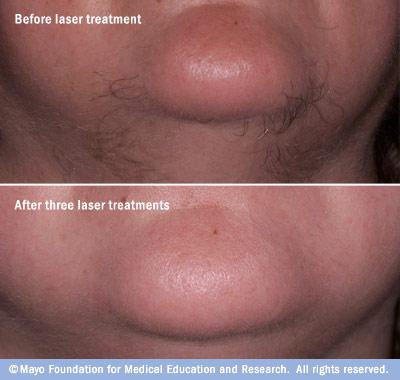By Mohamedmedo
Laser hair removal is a medical procedure that uses a laser — an intense, pulsating beam of light — to remove unwanted hair. During laser hair removal, a laser beam passes through the skin to an individual hair follicle. The intense heat of the laser damages the hair follicle, which inhibits future hair growth.
Laser hair removal is most effective for people who have light skin and dark hair. Although laser hair removal effectively slows hair growth, it doesn't guarantee permanent hair removal. It typically takes several laser hair removal treatments to provide an extended hair-free period. Periodic maintenance treatments may be needed as well.
Why it's done
Laser hair removallaser hair removal
Risks
Laser hair removallaser hair removal
- Skin irritation. Temporary irritation, crusting or scabbing is possible after laser hair removal.
- Pigment changes. Laser hair removal may darken or lighten the affected skin, usually temporarily. Skin lightening primarily affects those who have darker skin, especially if an incorrect laser is used at an incorrect setting.
Rarely, laser hair removal may cause blistering, scarring or other changes in skin texture
How you prepare
If you're interested in laser hair removal, choose a doctor who's board certified in a specialty such as dermatology or cosmetic surgery and has experience with laser hair removal. If a physician's assistant or licensed nurse will do the procedure, make sure the doctor supervises and is available on-site during the treatments. Be cautious about spas, salons or other facilities that allow nonmedical personnel to do laser hair removal. Before laser hair removal, schedule a consultation with the doctor. He or she will use this visit to:
- Review your medical history, including medication use
- Discuss risks, benefits and expectations, including what laser hair removal can and can't do for you
- Outline a treatment plan and related costs
- Take photos to be used for before-and-after assessments and long-term reviews
The doctor will also offer specific tips to prepare for laser hair removal. For example:
- Stay out of the sun. A tan increases the risk of side effects, such as blistering and discoloration. If you have a tan — either from sun exposure or sunless tanning products — wait until the tan fades completely before undergoing laser hair removal.
- Avoid plucking, waxing and electrolysis. These hair removal methods can disturb the hair follicle and interfere with laser hair removal. Shaving is OK, however, since it preserves the hair shaft and follicle. In fact, shaving may even be recommended. Some studies suggest that shaving before laser hair removal improves results.
What you can expect
Laser hair removal

Laser hair removallaser hair removal

The top photo shows a woman before laser hair removal. The bottom photo shows the results after three laser treatments
Results of laser hair removal vary greatly from person to person. Multiple treatments can prolong the duration of hair loss, but hair regrowth is still possible. For best results, you may need four to six treatments spaced a number of weeks apart. Additional periodic maintenance treatments — perhaps once every six to 12 months — may be needed as well.





































